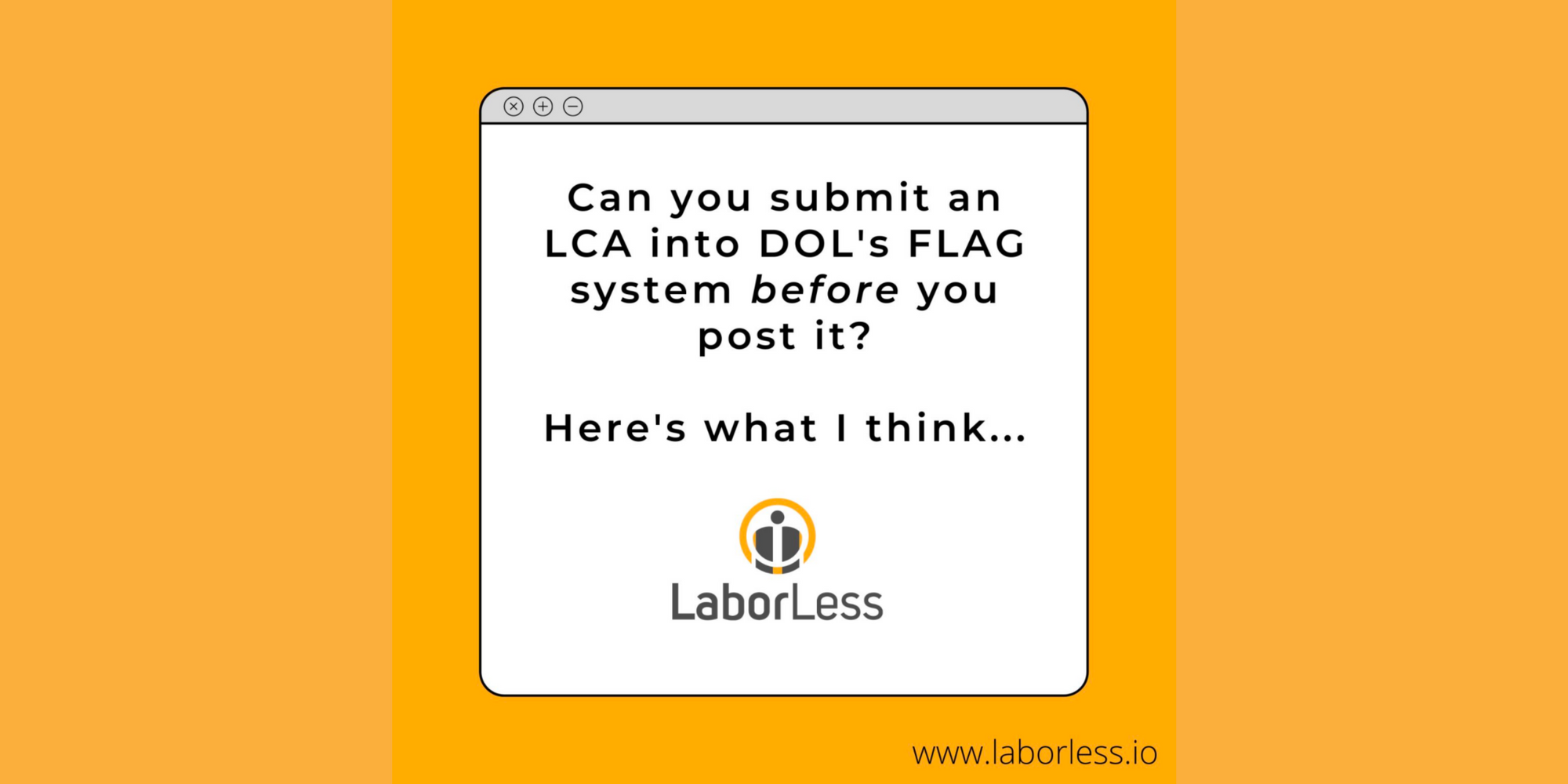Can you submit an LCA into the US Department of Labor’s FLAG system before you post it? Or do you have to post the LCA notice first and only then submit the LCA itself into FLAG?
Many, if not most immigration lawyers say no. For years they’ve first required confirmation that the LCA notice was posted before submitting the actual LCA data into FLAG, and this made sense given that the LCA notice had always been posted by the company’s HR or immigration department and, increasingly, by the H-1B candidate or beneficiary themselves at their their home or other remote place of work.
But a growing number of immigration lawyers, however, say you can submit LCA data into FLAG before posting the LCA notice. And I actually agree with this analysis, so I thought it made sense to analyze this question and how law firms can capitalize on it.
LCA posting has always been done prior to submitting the LCA into FLAG (previously iCert)
For a bit of context, DOL regulations at 20 CFR § 655.734(a)(1)(ii) state that an H-1B employer is required to provide sufficient notice to their workers when they are looking to hire or already employ a foreign national on an H-1B (or H-1B1 / E-3) visa - whether through an initial visa application, an extension of their visa, or when the foreign national moves to an area with potentially different wage requirements.
Specifically, the regulations state that, with regards to when posting has to happen, “notification shall be given on or within 30 days before the date the labor condition application is filed.”
A lot of lawyers I’ve spoken to only submit their client’s LCA information in FLAG once they’ve gotten confirmation that it's been posted. They would tell me that this is how it had been done for years, decades even, and that they’d never really thought twice about it. Their assumption was just that you’re supposed to wait until the LCA notice has been posted in order to submit the data.
But is that necessarily true?
Do the regulations allow for submitting the LCA and then posting notice?
If you read the regulations carefully, you’ll notice that they say, “...on or within 30 days before…” The focus here is on the word “on” because – and a growing number of immigration attorneys seem to agree – that means the LCA can be submitted into FLAG either before or after posting, as long as it’s on the same day as filing the LCA.
Why is this such a big deal?
Because it means that theoretically, if you submit LCA data in FLAG and then post the LCA notice afterwards, as long as it’s on the same day, you should still be compliant.
The biggest reason most immigration law firms never did it this way is because while the law firm would typically submit the LCA into FLAG (and previously iCert), the employer would still be the one posting it, Meaning there was no way to control whether the posting actually happened on the same day as filing.
And of course no one wants to risk submitting an LCA in FLAG and then having the LCA notice not get posted that day - DOL fines and sanctions are never worth it.
But what if the immigration law firm could control both the LCA submission and the posting process? In other words, what if the immigration law firm could not just submit the LCA in FLAG, but could also handle the LCA posting process? Well, with electronic LCA posting that’s now possible, and it makes the entire process easier too.
Electronic LCA posting enables law firms to file LCAs and post them too
Since the DOL issued a memo clarifying and giving more information about regulations around electronic LCA posting back in March 2019, more and more immigration lawyers have started to offer services whereby they handle the LCA posting and public access file process for their clients rather than asking their clients to post on their own.
How? Well, by posting LCA notices electronically, whether to an online LCA bulletin on the company’s career page, to the company’s intranet, or via other means, the in-house HR team no longer has to be the one posting their LCAs. Instead, their law firms are now able to log in and handle the posting for them.
Which means that if the law firm can now post LCAs and submit the LCA information into flag, they have control over both parts of the process, which makes it easier for the law firm to file the LCA first and then post the LCA notice, with the DOL case number (the I-20o.... number) in hand to boot. Law firms can even move away from creating “one page notices” and other extraneous things and instead use the “In Process” form ETA 9035 that FLAG provides for filed LCAs as part of the posting.
How can an immigration law firm easily offer this sort of service? This is where LaborLess comes in.
LaborLess automates electronic LCA posting and electronic public access file management
LaborLess makes it incredibly easy to post electronic LCA notices (and create and manage electronic PAFs too), and our law firm clients use it precisely to post LCA notices on behalf of their petitioner clients. It’s a win-win situation: the petitioner doesn’t need to deal with the LCA posting process anymore, the law firm has more control over the client's compliance, and a whole lot of trees are saved along the way.
So if you’re an immigration law firm interested in learning more about how you can support your clients by offering to handle their electronic LCA posting process, check out the LaborLess website and let’s set up a time to talk.
And if you’re an in-house immigration team that already has a robust process around LCA posting but you’re still printing notices in your offices or asking your remote employees to do the same in their homes (or both!), LaborLess can help you eliminate all that back-and-forth, gain better control over tracking your LCA postings, and introduce a more streamlined process into your immigration workflow!

